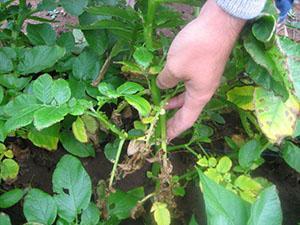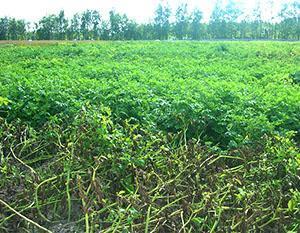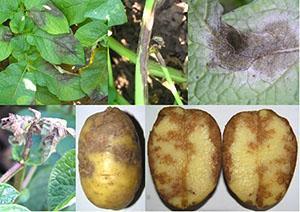Fight against potato late blight - chemical and biological means
 Late blight, or brown rot of potatoes, is a very common disease of nightshades, to a lesser extent affecting strawberries, buckwheat, castor oil plants. The name is translated from 2 Greek words: "plant" "I destroy". In Russia, potato losses from the disease are ≈ 4 million tons per year.
Late blight, or brown rot of potatoes, is a very common disease of nightshades, to a lesser extent affecting strawberries, buckwheat, castor oil plants. The name is translated from 2 Greek words: "plant" "I destroy". In Russia, potato losses from the disease are ≈ 4 million tons per year.
The causative agent is not entirely correct to relate to fungi (different classification systems - different data). In any case, drugs for treatment are called fungicides, which means “killing mushrooms”. Potatoes are infected with zoospores located in the ground, storage facilities, on post-harvest residues and unselected tubers. Infection of tubers can occur (as often happens) from infected tops: when it rains with water or when it comes into contact with potatoes during harvesting. In rainy and warm weather, the disease spreads quickly and can affect the entire field.
Read our article: potato diseases with photos and descriptions.
Typical symptoms of potato late blight disease

 Phytophthora on potatoes, the photo shows the defeat of various parts of the plant. The fight against the disease should be started at the first signs, and preferably before they appear. Only in this case it is possible to save the harvest and avoid mass destruction.
Phytophthora on potatoes, the photo shows the defeat of various parts of the plant. The fight against the disease should be started at the first signs, and preferably before they appear. Only in this case it is possible to save the harvest and avoid mass destruction.
Facts from history
 Late blight was the cause of the great famine in Ireland in 1845-1849. For several years, the population of the country has decreased by a quarter ... To escape, people tried to emigrate. On ships that previously served to transport slaves, people weakened by hunger and disease sailed to America. Mortality on ships reached 20-30% ... These depleted ships were called so: "coffin-ships" - coffin carriers, literally - a coffin-ship ... Songs are still sung about the "Great Potato Hunger", there are monuments, people remember ...
Late blight was the cause of the great famine in Ireland in 1845-1849. For several years, the population of the country has decreased by a quarter ... To escape, people tried to emigrate. On ships that previously served to transport slaves, people weakened by hunger and disease sailed to America. Mortality on ships reached 20-30% ... These depleted ships were called so: "coffin-ships" - coffin carriers, literally - a coffin-ship ... Songs are still sung about the "Great Potato Hunger", there are monuments, people remember ...
Control measures and prevention of the disease
In suitable weather, the disease develops very quickly, so first of all, pay attention to the prevention of the disease.
- Healthy planting material. It is good to warm up before planting for two weeks with the selected material and revise it again, removing tubers with the smallest signs of the disease.
- Selection of resistant varieties. Absolutely resistant ones do not exist, and yet the difference in the susceptibility of different varieties is significant.
- Removal of post-harvest residues. These are the source of infection. Mowing the tops before digging and removing them from the field also helps: if the leaves are affected, there may well be uninfected tubers. Until they meet sick tops.
- Maintaining crop rotation. We take into account that the pathogen, as written above, develops on other nightshades (also on buckwheat, castor oil and strawberries, but to a lesser extent), so planting potatoes after tomatoes or eggplant is a bad idea. Crop rotation is one of the important measures in the prevention of various plant diseases.
- Early cleaning. Keeping the tubers for some time in a dry place for ripening. Helps, especially in rainy, favorable weather for the fungus.
- Avoid unnecessarily thickened landings. In such cases, the disease develops faster.
- Hilling. In addition to the usual goals, this technique also protects tubers from infection.
- Choosing a landing site. In lower areas, the humidity is higher, moisture stagnates more often, which is what phytophthora needs.
- Don't overdo it with liming! Favors disease ...
- Spatial isolation. Both different potato fields and fields of other plants of the Solanaceae family - tomato, eggplant, because late blight affects them as well.
- We adhere to agricultural technology. Plants, like people, are easier to get infected and get sick more weakened by poor conditions of development.
- We use top dressing wisely. Introduction nitrogen drives the tops and often increases the yield, but increases the incidence. But the introduction of potassium or micronutrient fertilizers, in particular copper, on the contrary, protects the plants.
We begin the first treatments before signs of the disease appear!
 This is especially important if the weather is rainy or foggy. The appearance of edible mushrooms in the forests is very approximate, but still a sign: it's time to start processing. Moreover, we spray it periodically, once every two weeks or ten days. How to treat potatoes from late blight? With any fungicides, the choice is yours - in a store, at a company or at a bazaar, the assortment is huge, we buy and add according to the instructions. But people use other remedies for late blight on potatoes, they are treated not only with fungicides. The result is controversial, there are many fans of different methods, but completely trust ... you should beware. On the other hand, what if it helps? So, spray.
This is especially important if the weather is rainy or foggy. The appearance of edible mushrooms in the forests is very approximate, but still a sign: it's time to start processing. Moreover, we spray it periodically, once every two weeks or ten days. How to treat potatoes from late blight? With any fungicides, the choice is yours - in a store, at a company or at a bazaar, the assortment is huge, we buy and add according to the instructions. But people use other remedies for late blight on potatoes, they are treated not only with fungicides. The result is controversial, there are many fans of different methods, but completely trust ... you should beware. On the other hand, what if it helps? So, spray.
- Milk, skimmed milk or whey (diluted).
- Tincture of garlic.
- Trichopolom (buy at the pharmacy) tablet / liter of water.
- Iodine (buy in the same place). However, they are usually combined, when spraying with milk, add 10-15 drops / liter of iodine.
- Tincture on superphosphate.
- A weak solution of copper sulfate.
 Iodine, vitriol, superphosphate, you can also add potassium fertilizer - this is not only and not so much protection against late blight, but also foliar feeding of plants. And dairy products form a protective film on the surface of the leaves, which prevents the pathogen from entering the plant. And yet, the most reliable are precisely proven chemicals. Which is better - it's hard to say, all firms praise their own, but still, any drugs are thoroughly tested before going on sale. And further. We look through and remove diseased leaves, of course, if the time and area of planting permits - a huge field cannot be processed like that. Read:recipe for potato pancakes with onions!
Iodine, vitriol, superphosphate, you can also add potassium fertilizer - this is not only and not so much protection against late blight, but also foliar feeding of plants. And dairy products form a protective film on the surface of the leaves, which prevents the pathogen from entering the plant. And yet, the most reliable are precisely proven chemicals. Which is better - it's hard to say, all firms praise their own, but still, any drugs are thoroughly tested before going on sale. And further. We look through and remove diseased leaves, of course, if the time and area of planting permits - a huge field cannot be processed like that. Read:recipe for potato pancakes with onions!
A detailed qualitative article has highlighted almost all methods of dealing with late blight. Despite the fact that it covers the issues of foliar processing, little space is given to processing with the latest biological preparations. The use of EM-1 in conjunction with phytosporin mutually enhances the effect of living cultures and makes it possible to do without treatment with copper preparations until the end of July. The use of EM-1 Baikal on potatoes for pre-planting soaking of tubers and two spraying during the summer, delayed the development of the disease until August.It was not possible to get rid of it completely in the absence of crop rotation, and located across the border of sick potato beds of neighbors. However, late blight did not have time to develop, and potatoes were dug out on a green leaf. Regular examinations were carried out to contain the disease. Bushes touched by late blight were immediately removed. Watering plants should be rare and only along the furrows without wetting the bush. It is important not to delay harvesting. Then late blight can only remain on the stems and leaves. The foliage, which is dried on the fence in autumn, is an excellent carrier of infection, and the wind is its transport.
Late blight control measures.
Control measures. Breeding of late blight-resistant potato varieties is recommended; fertilization of the soil with potassium-phosphorus fertilizers; processing of planting material with copper, boron, manganese; planting is carried out only with healthy tubers; germination of planting material in the light accelerates the development of plants and allows them to get away from the terms of intensive development of late blight; timely hilling, protects young tubers from infection; treatment of potato plantations in the phase of full germination (after about 15 days) with microelements and simultaneous feeding with basic nutrients; optimal storage conditions (warehouses must be cleaned, ventilated and disinfected one month before loading them with potatoes, storage temperature 1 ... 3 ° C, air humidity (85 ... 90%); selection of infected tubers before storing them); clearing the territory near the heaps and storage sites from potato dumps.
The pathogen affects all parts of the potato. The disease is characterized by manifestation. Primary symptoms appear in the second half of summer on the leaves (at the beginning of flowering). Vague brown spots appear on the edges of the lower leaves, which are ringed with a clearly visible white fluffy bloom. Over time, white spots grow, and the white banding moves towards healthy tissue and sporulation appears in the form of white plaque at the junction of healthy and diseased tissue. Elongated brown stripes appear on the petioles and stems, which is a manifestation of the disease.